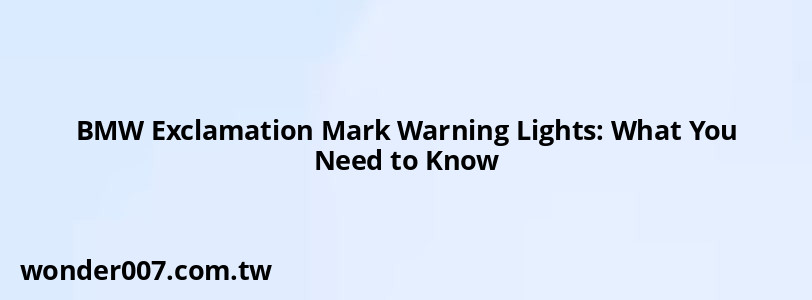BMW Exclamation Mark Warning Lights: What You Need to Know

The BMW exclamation mark warning lights can often leave drivers puzzled and concerned about their vehicle's condition. Understanding these warning lights is crucial for maintaining your BMW and ensuring your safety on the road.
Understanding the Exclamation Mark Warning Lights
The exclamation mark in a triangle or circle on your BMW dashboard indicates a general warning that something requires your attention. It can signify various issues, from minor alerts to more serious problems.
Common Types of Exclamation Mark Warnings
- Brake System Warning Light: This light, often depicted as a circle with an exclamation mark, signals potential issues with your braking system. It could indicate low brake fluid levels or worn brake pads. Immediate inspection is advised to prevent brake failure.
- Tire Pressure Warning Light: Shown as a tire with an exclamation mark inside, this light warns that one or more tires may be under-inflated. Check your tire pressure to ensure safe driving conditions.
- Dynamic Stability Control (DSC) Warning: This symbol appears when there is a problem with the traction control system. If this light stays on, it could mean that the system is deactivated or malfunctioning, which may affect your vehicle's stability, especially in slippery conditions.
What to Do When the Warning Light Activates
When you see any exclamation mark warning light, it’s essential to take the following steps:
- Check Your Dashboard Messages: Use your iDrive system or dashboard display to get more information about the specific issue.
- Assess the Severity: If the light is yellow, it indicates a non-critical issue that requires attention soon. A red light signifies a serious problem that needs immediate action.
- Take Action: Depending on the warning, you may need to check fluid levels, tire pressure, or even consult a professional mechanic for diagnosis and repair.
FAQs About BMW Exclamation Mark Warning Lights
- What does the yellow triangle with an exclamation mark mean?
This symbol indicates a general warning that requires your attention. It can relate to various issues such as low fuel, tire pressure problems, or traction control system malfunctions. - Can I continue driving with the warning light on?
It depends on the underlying issue. If it’s a minor alert like low washer fluid, you can continue driving but should address it soon. For serious warnings related to brakes or tire pressure, stop driving immediately and inspect the issue. - How do I reset the warning light?
After addressing the underlying issue, many lights reset automatically. If they don’t turn off, refer to your owner’s manual for specific reset instructions or consult a professional.
Understanding these warning lights and their implications can help you maintain your BMW effectively and ensure a safe driving experience. Always prioritize addressing any alerts promptly to keep your vehicle running smoothly.
Related Posts
-
Forklift Warning Light Symbols: Essential Guide for Operators
26-01-2025 • 151 views -
Jeep Cherokee Interior Lights: Troubleshooting Guide
29-01-2025 • 131 views -
How To Turn Off Nissan Altima Master Warning Light: A Complete Guide
26-01-2025 • 156 views -
Ford Expedition Dashboard Warning Lights Guide
26-01-2025 • 168 views -
SRS Warning Light: What It Means for Your Safety
28-01-2025 • 113 views
Latest Posts
-
How To Turn Off Paddle Shifters Mercedes
01-02-2025 • 306 views -
2015 Chevy Traverse AC Recharge Port Location
01-02-2025 • 339 views -
Are O2 Sensors Covered Under Warranty
01-02-2025 • 312 views -
Rear Brake Caliper Piston Won't Compress
01-02-2025 • 287 views -
Power Steering Fluid Leak On Passenger Side
01-02-2025 • 392 views
Popular Posts
-
2015 VW Passat Oil Consumption Issues Explained
26-01-2025 • 543 views -
EPC Warning Light: What It Means for Your Vehicle
27-01-2025 • 559 views -
Power Steering and ABS Light On: Causes and Solutions
27-01-2025 • 582 views -
EPC Light: Understanding Causes and Solutions
26-01-2025 • 990 views -
V12 Engine Costs: What You Need to Know
26-01-2025 • 584 views
